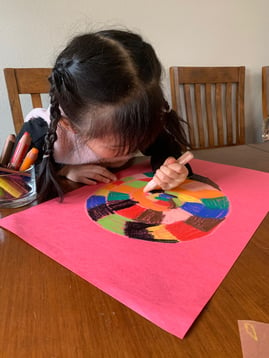![]()
As we have quickly and unexpectedly shifted to the new reality of Distance Learning, our students’ laptops and iPads have been a lifeline – allowing them to connect with their teachers and classmates and continue to learn in a very challenging situation.
However, as parents and teachers, we also find ourselves, by necessity, allowing our children way more screen time than we would normally be comfortable with.
As a school, we have been working on ways to reduce student screen time while continuing to support their academic progress in the best way possible. This became especially important once we realized that our school closure would extend far longer than the two weeks we had originally planned for.
Here are a few insights about Distance Learning beyond the screen from our teachers and principals:
 Balancing synchronous and asynchronous learning. Live Zoom meetings have proven invaluable for our teachers – for morning wellness time, giving instructions for projects, allowing students to give presentations, and maintaining class spirit/cohesion. However, we have begun to introduce more asynchronous learning time to our curriculum, when our students are given tasks or projects to complete independently offline, and then submit/check back in with their teachers (depending on grade level). Asynchronous learning, in addition to helping reduce screen time, also helps students build independence, responsibility, and self-management skills.
Balancing synchronous and asynchronous learning. Live Zoom meetings have proven invaluable for our teachers – for morning wellness time, giving instructions for projects, allowing students to give presentations, and maintaining class spirit/cohesion. However, we have begun to introduce more asynchronous learning time to our curriculum, when our students are given tasks or projects to complete independently offline, and then submit/check back in with their teachers (depending on grade level). Asynchronous learning, in addition to helping reduce screen time, also helps students build independence, responsibility, and self-management skills.
There are so many ways to learn outside of school. Our Assistant Head of School Kate Conway, who is also a school parent herself, says “I think it’s important to remember as parents that there are so many opportunities for our children to learn in addition to what the school is providing. Things like cooking, exercising together, playing games, going for walks and asking wondering questions, are all really great ways to engage your children in learning. Children are natural learners, and they will naturally ask questions and wonder about things, and taking the time to answer them is a great way to learn as a family.”
It’s okay to be bored! Boredom is actually good for kids – their best, most creative ideas often surface from a state of boredom. There is no need to try to schedule every hour of a child’s day. Not only is this nearly impossible when we are all learning/working from home together, it is also not beneficial for the long-term sustainability of distance learning. If your child is bored, instead of immediately suggesting an activity or allowing more screen time, leave them alone and they will begin to create their own game, design their own art project, read a book, or even simply daydream.
Being mindful of devices is now even more important. When students are spending more time with screens during the day, families need to be sure that devices are put away after school hours, are not kept in bedrooms, and that everyone is getting plenty of fresh air and physical activity.
Each week, our Assistant Head of School Kate Conway updates the community about our Distance Learning initiatives. Check out her video from our second week of Distance Learning, where she discusses many of the issues addressed in this blog.




